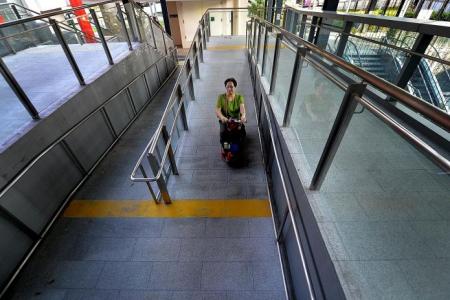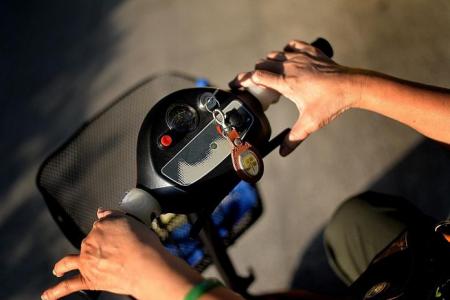Wheel zeal
Woman with walking disability discovers freedom and independence after buying mobility scooter
It may be just a mobility scooter to you or me, but for Madam Elsie Tan, it has given her a new lease on life.
Madam Tan, 67, had polio as a child and had no control of her left leg.
She says: "I couldn't walk because my legs were very soft till I was 10 years old. When I went to school, my sister carried me for two years."
Before getting a mobility scooter, her only aid was her husband of 38 years. He is a taxi driver.
"My husband used to be my walking stick. I had to hold on to him when walking, but it was not very convenient.
"There were times when he was not in the mood to go out when I wanted to, so he would go out with me - with a gloomy face," she recalls with a laugh.
Gesturing to her mobility scooter, which she has had for six years, she says: "This one allows me to be very independent and gives me freedom.
"I can go out anytime and I don't have to rely on my husband."
Madam Tan moves around effortlessly as she rides her mobility scooter out of her HDB flat in Serangoon to take the bus and the MRT.
It was much tougher when she was young. In school, a health inspector had her fitted with callipers, which she wore till she was in Primary 6.
It was only after she completed secondary school that she went for an operation to help her walk properly.
"After that operation, I was able to walk. I felt on top of the world," Madam Tan says.
She had to rely heavily on her right leg to support her. But then her "good leg" had problems.
"It's because all the while I have been using my good leg to support my weak left leg, so I think the good leg got exhausted. Now it is giving me trouble."
Now, she goes everywhere with her mobility scooter, which she bought for $2,300 six years ago. Her two sons had split the cost with her.
She had found the Falcon Mobility website when she searched online for mobility scooters.
Madam Tan has met others who have difficulty moving, but are reluctant to get a mobility scooter.
SHY
"It is very convenient, but a lot of people feel shy and don't dare go out. I tell them that if they don't go out, they will miss the world," Madam Tan says.
She has taught a stranger how to use the scooter and even accompanied him as he built up confidence.
The man has since explored places he had never visited, such as Singapore Botanic Gardens and Pasir Ris Park.
Madam Tan says people here are patient with those with disability.
But there have been problems, too.
While she finds travelling on public transport pleasant, there have been one or two sour experiences.
She recalls an incident with a public bus driver: "I stopped the driver and he was smiling at me, but he let all the people go up the bus first, until the bus was quite full.
"He then told me to wait for another bus. I told him it was my third bus and the last two were not accessible. I said, 'If you ask me to wait, are you sure the next bus is accessible?'"
She then insisted on boarding the bus. "I know where I stand on this," she says with conviction.
In spite of the challenges, she thoroughly enjoys the freedom the mobility scooter gives her.
"I feel luckier now, I get to see the world for myself."
"It is very convenient, but a lot of people feel shy and don't dare go out. I tell them that if they don't go out, they will miss the world."
- Madam Elsie Tan, 67
Financial help for buying scooter
There's a government fund to help those who need a motorised scooter for the elderly.
The Senior's Mobility Fund, set up in 2011, is managed by the Agency for Integrated Care. It is designed to help poor seniors aged 60 and above stay mobile.
The fund was expanded from $10 million in 2011 into a $50 million Seniors' Mobility and Enabling Fund in 2013.
It can be used to help buy mobility aids, provide people with dispensable items such as diapers or subsidise transport to places such as elder care centres.
But those who turn to the fund for help may need to pay 10 per cent of the cost. A walking stick might cost only $1.
Those on public assistance can also turn to the Community Development Council for more help with funding.
By last year, more than 6,000 people had tapped the fund. Following the launch of the scheme, several Members of Parliament initiated awareness programmes to let the elderly know about the help at hand.
Senior Minister of State for Law and Education Indranee Rajah, who is also an MP for Tanjong Pagar GRC, launched a programme to provide free motorised scooters for the elderly. They are parked at participating senior activity centres in the constituency.
The fund is available for elderly people living in three-room or smaller flats, or those with a household income less than $1,800. They are eligible for a 90 per cent subsidy on devices that cost $500 or less.
About 40 seniors have signed up so far.
Mobility scooters more popular than wheelchairs
Vendors say more people are buying mobility aids such as mobility scooters and motorised wheelchairs.
A quick online search turned up five shops selling mobility aids.
Mr Warren Chew, managing director of Falcon Mobility, says his business has been growing since its inception in 2008. He used to sell one to three mobility scooters a month, but now easily sells 50 units a month.
"In one week, the number of units sold can be in the double digits," says Mr Chew, adding that while fewer motorised wheelchairs are sold, the figure is holding steady.
Two companies The New Paper on Sunday spoke to estimate that there are between 3,000 and 5,000 mobility scooters and motorised wheelchairs being used here.
Mr K. N. Lee, 60, who runs Delcon Technology, says sales has increased by 3 to 5 per cent every year.
He says: "Awareness is increasing and the facilities are becoming more accessible. With government funding, more of the elderly are able to use these mobility scooters."
The companies say the bulk of their users are the elderly and those with physical disabilities.
Mr Chew says: "There is the misconception that mobility scooters are not wheelchairs because they can also be used by the healthy.
"But out of a 100 mobility scooter users, 99 per cent have a partial or complete walking disability."
FASTER
He adds that electric scooters go much faster for the same price.
At Falcon Mobility, mobility scooters range from $1,450 to $2,800. Motorised wheelchairs cost between $2,300 and $3,800.
Mr Chew says 80 per cent of his customers are children or relatives buying the scooters or chairs for their parents.
He adds: "Some prefer to pay a bit more for their parents.
"Children are more willing to buy extended warranties to have peace of mind for their parents."
World's lightest scooter

NEW DESIGN: The Falcon e-Lite Mobility Scooter weighs 16.3kg and costs $2,500. PHOTO: FALCON MOBILITY
Local company Falcon Mobility is the first here to design and produce a mobility scooter.
It recently made the world's lightest scooter which the company says is also cheaper than comparable models.
The Falcon e-Lite Mobility Scooter, which weighs 16.3kg, costs $2,500.
It was first showcased at RehabTech Asia 2015 at Singapore Expo which ended yesterday.
The scooter is light and small enough to be easily picked up and fitted into the boot of a car.
It took the company two years to produce the scooter with the help of Spring Singapore, under the Capability Development Scheme.
Get The New Paper on your phone with the free TNP app. Download from the Apple App Store or Google Play Store now



